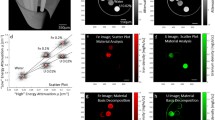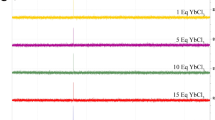Abstract
Electron energy loss spectroscopy (EELS) is a high spatial resolution electron microscopic technique with the potential to quantify elements at the subcellular level. The presence of each element is demonstrated by the electron energy loss edge at the energy characteristic of that element. The area of the edge may indicate the quantity of element present. Electron spectroscopic imaging (ESI) is a similar technique generating graphic images of elemental localization in the specimens. An ESI of an aluminum (Al)-loaded rabbit hippocampus showed Al only in pyramidal cell lysosomes, but no EELS edge could be obtained. To determine the sensitivity of EELS for Al and to be able to adjust the instrument to optimal operating conditions, standards containing 50–5000 ppm Al were produced. An Al-chloride:dicyclohexano-18-crown-6 (Al:crown) complex was synthesized. The purity of the complex was confirmed by nuclear magnetic resonance (NMR) spectroscopy and the percentage of Al in the complex was determined by electrothermal atomic absorption spectroscopy (ETAAS). The complex was introduced into a biological tissue embedding resin (Spurr medium) and appeared to be compatible with the resin at Al concentrations ≤500 ppm. EELS signals from the Al K edge could be obtained at a spatial resolution of 3.3 nm in a 30-nm thick section from 2.78×10−21 g of Al, representing a sample concentration of 1% Al.
Similar content being viewed by others
References
R. F. Egerton,Electron energy-loss spectroscopy in the electron microscope, Plenum, New York, 1986.
M. A. Mignon-Conté, J. P. Pourrat, F. Carentz, J. Sévely and J. J. Conté,Eur. J. Clin. Invest. 12, 27 (1982).
A. L. Arsenault, F. P. Ottensmeyer, and A. B. Hodsman, inClinical disorders of bone and mineral metabolism, B. Frame and J. T. Potts eds., Excerpta Medica, Princeton, NJ, 1983, pp. 220–223.
J. Böhmer and H. Rahmann,Ultramicroscopy 32, 18–25 (1990).
J. Böhmer and H. Rahmann,J. Microsc. 162, 115–122 (1991).
V. W. Linss, R. Martin, G. Stein, H. Bräunlich and C. Fleck,Acta Histochem. 90, 65–73 (1991).
V. W. Linß, R. Martin, G. Stein, H. Bräunlich and C. Fleck,Acta Histochem. Suppl. 42, S 273–276 (1992).
C. L. Webb, F. J. Schoen, W. E. Flowers, A. C. Alfrey, C. Horton and R. J. Levy,Am. J. Path. 138, 971–981 (1991).
M. J. Hendrick, M. H. Goldschmidt, F. S. Shofer, Y.-Y. Wang and A. P. Somlyo,Cancer Res. 52, 5391–5394 (1992).
A. R. Spurr, inMicroproble analysis as applied to cells and tissues, J. A. Hall, P. Echlin and R. Kaufmann, eds., Academic, London and New York, 1974, pp. 213–227.
A. R. Spurr,J. Microscopie Biol. Cell 22, 287–302 (1975).
J. F. Muller, M. A. Gelot, P. Netter and R. Kaufmann,Biomedicine 36, 380–383 (1982).
A. H. Verbueken, R. E. Van Grieken, G. J. Paulus and W. C. de Bruijn,Anal. Chem. 56, 1362–1370 (1984).
J. M. Candy, A. E. Oakley, S. A. Mountfort, G. A. Taylor, C. M. Morris, H. E. Bishop and J. A. Edwardson,Biol. Cell 74, 109–118 (1992).
M. A. Lovell, W. D. Ehmann and W. R. Markesbery,J. Trace Microprobe Tech. 10, 109–124 (1992).
J. J. Godleski, R. C. Stearns and E. J. Millet, inProceedings of the 47th Annual Meeting of the Electron Microscopy Society of America, G. W. Bailey, ed., San Francisco Press, San Francisco, CA 1989, p. 404, 405.
N. R. Strel'tsova, V. K. Bel'skii, L. V. Ivakina, P. A. Storozhenko and B. M. BulyshevKoord. Khim. 13, 1101–1108 (1987).
R. A. Yokel and J. M. Melograna,Biol. Trace Elem. Res. 5, 225–237 (1983).
P. Galle, M. Chatel, J. P. Berry and F. Menault,Nouv. Presse Med. 8, 4091–4094 (1979).
C. J. Pedersen and H. K. Frensdorff,Angew. Chem. Int. 11, 16–25 (1972).
S. G. Bott, H. Elgamal and J. L. Atwood,J. Am. Chem. Soc. 107, 1796–1797 (1985).
Author information
Authors and Affiliations
Additional information
An erratum to this article is available at http://dx.doi.org/10.1007/BF02990491.
Rights and permissions
About this article
Cite this article
Xie, X., Yokel, R.A. & Markesbery, W.R. Application of electron energy loss spectroscopy and electron spectroscopic imaging to aluminum determination in biological tissue. Biol Trace Elem Res 40, 39–48 (1994). https://doi.org/10.1007/BF02916819
Received:
Accepted:
Issue Date:
DOI: https://doi.org/10.1007/BF02916819




